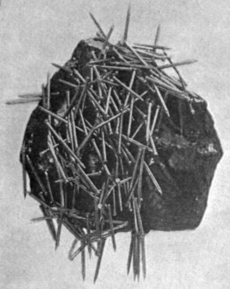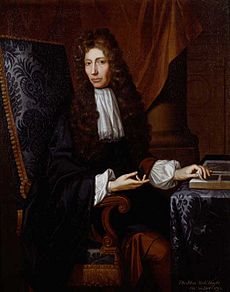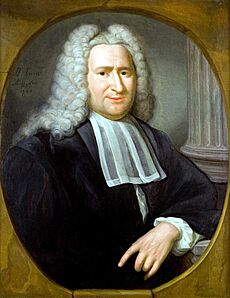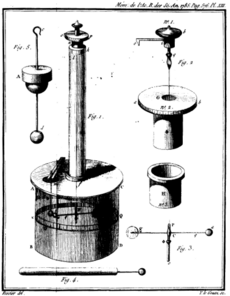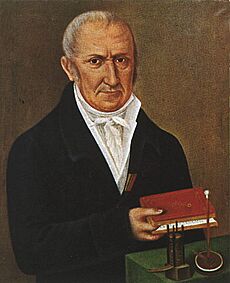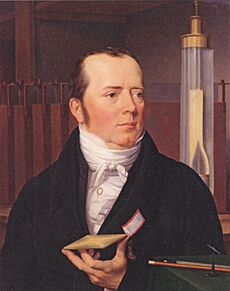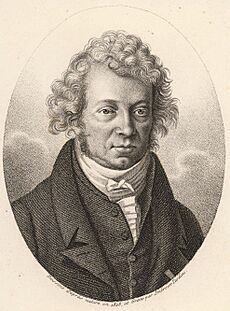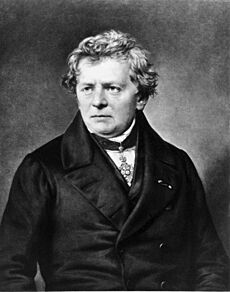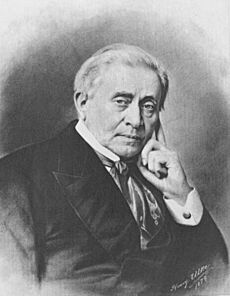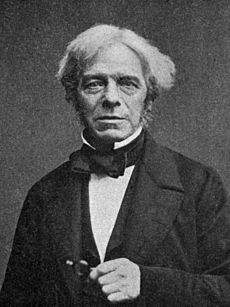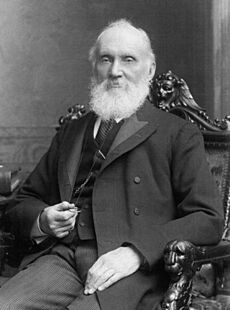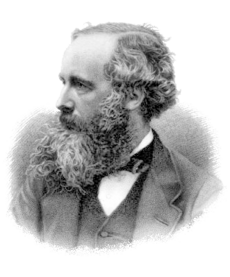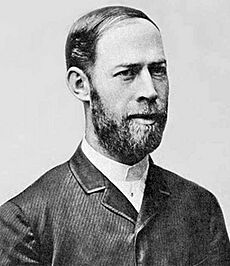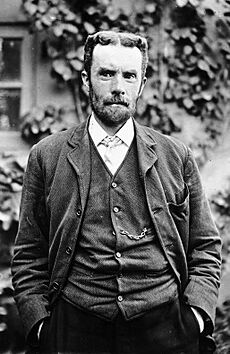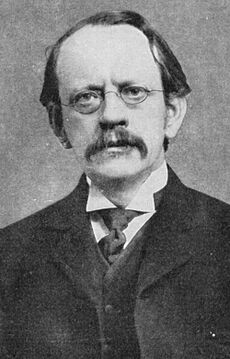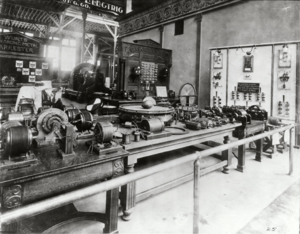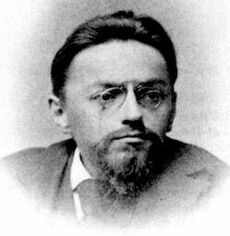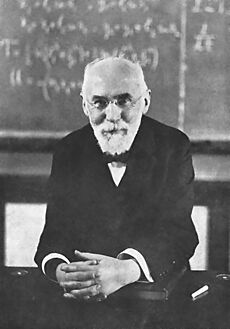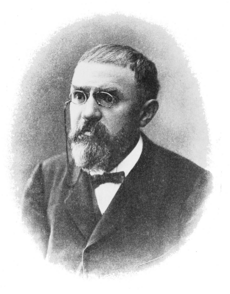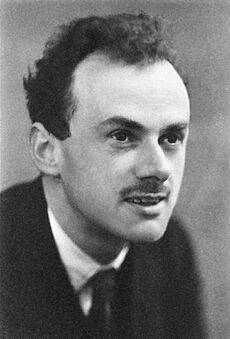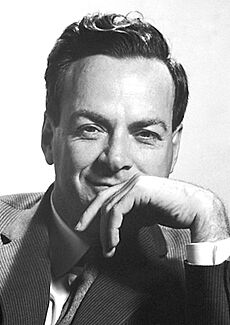History of electromagnetic theory facts for kids
The history of electromagnetism is about how people slowly learned about electricity and magnetism. For a long time, people didn't understand these forces. They couldn't explain things like lightning. But over hundreds of years, smart scientists like André-Marie Ampère, Michael Faraday, and James Clerk Maxwell helped us understand more.
In the 1800s, it became clear that electricity and magnetism are actually connected. When electric charges move, they create an electric current. This current then causes magnetism. So, electric charges create electric fields, and moving charges (currents) create magnetic fields.
Contents
- Early Discoveries of Electricity and Magnetism
- Magnets and Compasses in the Middle Ages
- The 1600s: New Words and Experiments
- The 1700s: Big Steps Forward
- The 1800s: Electricity and Magnetism United
- The 1900s: Quantum and Relativity
- The 2000s: New Technologies and Unanswered Questions
- Images for kids
- See also
Early Discoveries of Electricity and Magnetism
People have known about static electricity for a very long time. But for thousands of years, it was just a strange mystery. They often mixed it up with magnetism. Ancient people knew about two special materials: amber and lodestone. When you rubbed amber, it could pick up light things like feathers. Lodestone could attract iron.
Some scientists think that the ancient Olmec people in Central America might have used lodestone as a compass even before 1000 BC. This would be much earlier than the Chinese, who are usually given credit for the compass. The Olmecs might have used these tools to help build their temples or for other special purposes.
People also knew about the effects of electricity from nature. They saw lightning and St. Elmo's fire. But they didn't know these were all types of electricity. Ancient Egyptians knew that some fish, like the electric catfish, could give you a shock. They called these fish "thunderer of the Nile" and thought they were protectors.
Around 600 BC, a Greek thinker named Thales noticed that rubbing fur on amber made it attract dust. He was writing about what we now call static electricity. The Greeks even saw sparks jump if they rubbed the amber enough.
Later, Roman and Arabic scientists also wrote about these electric effects. They knew that touching electric fish could numb parts of the body. Some even thought these shocks could cure illnesses like headaches!
In Iraq, some objects called the Baghdad Battery were found. They date back to the early AD centuries. Some people think they were used to make electricity, maybe for electroplating (coating metal with another metal). But this idea is still debated.
Long ago, thinkers like Aristotle thought that magnets worked because they had a "soul" inside them.
Magnets and Compasses in the Middle Ages
The compass with a magnetic needle was invented in the 1000s. This helped sailors find their way much better. A Chinese scientist named Shen Kuo wrote about the compass in 1088. By the 1100s, Chinese sailors were using them. In Europe, the compass was described by Alexander Neckam in 1187.
In the 1200s, Peter Peregrinus did experiments with magnets. He wrote the first detailed book about how magnets work. He also described how compass needles move. Around 1300, an Italian inventor named Flavio Gioja invented the dry compass.
Some old stories say that people could even draw sparks from their bodies or clothes, similar to how static electricity works today.
In 1550, an Italian doctor named Gerolamo Cardano wrote about electricity. He was one of the first to say that electric forces and magnetic forces were different.
The 1600s: New Words and Experiments
In the late 1500s, William Gilbert, a doctor for Queen Elizabeth I, wrote an important book called De Magnete. He used the word "electrica" from the Greek word for amber, elektron. This is where our word "electricity" comes from!
Gilbert did many careful experiments. He found that many things besides amber, like glass and wax, could also become electric when rubbed. He also learned that hot objects lost their electricity. And moisture stopped things from becoming electric because water helps electricity move away. He noticed that electric things attracted all other objects, but magnets only attracted iron. Because of his many discoveries, Gilbert is called the "founder of electrical science."
After Gilbert, Robert Boyle (a famous scientist) continued the work. He found that electric objects could attract light things even in a vacuum. This showed that air wasn't needed for electricity to work. He also added more materials to the list of "electrics."
In 1663, Otto von Guericke invented a machine that could make static electricity. It was one of the first electrostatic generators. But he didn't realize it was mainly an electrical device. By the end of the 1600s, people had better ways to make electricity using friction. These machines became very important tools for studying electricity in the 1700s.
The word "electricity" was first used by Thomas Browne in 1646. The word "electromagnetism" first appeared in a book by Athanasius Kircher in 1641.
The 1700s: Big Steps Forward
Better Electric Machines
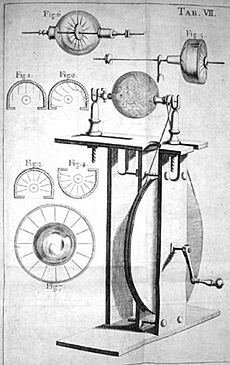
Electric machines got better thanks to people like Francis Hauksbee and Georg Matthias Bose. Bose was the first to use a "prime conductor" in these machines. This was an iron rod held by a person standing on an insulating block. This helped collect more electricity.
In 1746, Jan Ingenhousz invented electric machines made of glass plates. Scientists also found that a glass plate covered with tin foil on both sides could store a lot of electric charge. This was the Leyden jar.
Other improvements included using a glass cylinder instead of a globe and adding a "rubber" cushion to create more friction. John Canton made machines even better by adding a tin mixture to the rubber.
Conductors and Insulators
In 1729, Stephen Gray did experiments that showed the difference between materials that conduct electricity and those that don't (insulators). He found that metal wire and even hemp string could carry electricity. But silk could not. He showed that electricity could travel through 800 feet of hemp string if it was held up by silk loops. If he used brass wire instead of silk, the electricity disappeared. He called materials like glass and silk "electrics" (insulators) and metals and water "non-electrics" (conductors).
Two Kinds of Electricity
In 1732, C. F. du Fay continued Gray's work. He found that almost all objects could be made electric by rubbing or by using an electric machine. This changed Gray's idea.
In 1733, Du Fay discovered two types of electricity from rubbing. One came from rubbing glass, and the other from rubbing resin. He thought electricity was made of two fluids, "vitreous" and "resinous." These fluids separated when rubbed and canceled each other out when combined. This idea led to Benjamin Franklin's idea of "positive" and "negative" charges.
The Leyden Jar: Storing Electricity
The Leyden jar was invented by Ewald Georg von Kleist in 1744 and Pieter van Musschenbroek in 1745. It was a way to store large amounts of electrical energy. Von Kleist got a strong shock when he accidentally touched a bottle with an iron nail near his electric machine. Musschenbroek had a similar experience. William Watson improved the Leyden jar by covering it inside and out with tin foil.
In 1746, Jean-Antoine Nollet did an interesting experiment. He connected 200 monks hand-in-hand with iron wires in a big circle (about 1 mile long). When he sent an electric shock, they all felt it at the same time. This showed that electricity travels very fast. In 1749, William Watson did similar tests and found that electricity seemed to travel instantly over long wires. This hinted at the idea of sending signals using electricity.
Around 1750, people started trying to use electricity for medicine. They tested if electric shocks could help with illnesses like gout or paralysis. Some even thought electricity could make plants grow faster!
Franklin and Lightning
Benjamin Franklin became famous for his experiments with electricity. His most well-known (and very dangerous) experiment involved flying a kite in a thunderstorm. A key on the kite string sparked and charged a Leyden jar. This proved that lightning is a form of electricity. After this, he invented the lightning rod to protect buildings.
Franklin also suggested that electricity was a single "fluid" that was normally spread out evenly. When you rubbed glass, it gained too much fluid (positive). When you rubbed wax, it lost fluid (negative). This was different from the "two-fluid" theory.
Before Franklin's kite experiment, many scientists thought electricity and lightning were similar. But Franklin was the first to suggest a way to prove it. His work made many other scientists eager to study electricity.
Scientists like Michael Faraday, Luigi Galvani, Alessandro Volta, and André-Marie Ampère built on Franklin's ideas. Their work created the basis for modern electrical technology. Many units of electrical measurement are named after them.
In the late 1700s, Franz Aepinus and Henry Cavendish also made big contributions. Aepinus was one of the first to think about how electricity and magnetism are connected. He improved Franklin's theory, saying that electric fluid particles push each other away but attract particles of other bodies. He also studied how certain crystals, like tourmaline, become electric when heated (this is called pyroelectricity).
Henry Cavendish also had a similar theory of electricity. In 1784, he used an electric spark to mix hydrogen and oxygen to create pure water. He also discovered how well different materials could store electric charge (their dielectric capacity).
Around 1784, Charles-Augustin de Coulomb invented the torsion balance. With it, he discovered Coulomb's law. This law states that the force between two electric charges gets weaker as the square of the distance between them. This was a very important discovery for understanding electricity.
People also started thinking about using electricity to send messages over long distances. In 1774, Georges-Louis Le Sage created a system with 24 wires, each representing a letter. When a wire was charged, a small ball at the other end would move. This was an early idea for a telegraph.
Voltaic Electricity: A New Kind of Current
A huge change came with the discovery of galvanic electricity. Alessandro Volta found that chemical reactions could create electricity. He made the first electric battery by stacking different metals and wet paper. This created a steady flow of electricity, unlike the quick sparks from static machines. The unit of electrical potential, the volt, is named after him.
In 1767, Johann Georg Sulzer noticed a strange taste when he put zinc and copper on his tongue and touched them together. This was an early sign of voltaic electricity.
In 1790, Luigi Galvani saw a frog's legs twitch when they touched different metals near an electric machine. He thought the electricity came from the frog itself ("animal electricity"). But Volta disagreed. Volta believed the electricity came from the two different metals touching. This argument led to Volta inventing his battery.
Volta's battery was a major breakthrough. It was the first way to get a continuous flow of electricity. Soon after, scientists used Volta's battery to split water into hydrogen and oxygen.
The 1800s: Electricity and Magnetism United
Early 1800s: Batteries and Electrochemistry
In 1800, Alessandro Volta built the first true electric battery. This allowed scientists to have a steady source of electric current. Napoleon was so impressed that he invited Volta to show his experiments.
In 1806, Humphry Davy used a powerful battery to break down potash and soda. He showed that these were compounds of new metals: potassium and sodium. This was the start of electrochemistry, the study of how electricity and chemical reactions are linked. In 1833, Michael Faraday announced his laws of electrochemistry. He showed that the amount of a substance produced by electricity depends on the amount of electricity used.
Davy also gave the first public demonstration of the electric arc lamp in 1809.
It took some time for scientists to realize that electricity from batteries, static electricity, and "animal electricity" were all the same thing. By 1833, Faraday clearly stated that electricity, no matter where it comes from, is identical in its nature.
In 1820, Hans Christian Ørsted made a huge discovery. He found that an electric current flowing through a wire could make a nearby compass needle move. This was the first clear link between electricity and magnetism!
This discovery quickly led to more research. A few months later, André-Marie Ampère developed a new theory called electrodynamics. He showed that electric currents create magnetic forces. He found that:
- Two parallel wires with currents flowing in the same direction attract each other.
- Two parallel wires with currents flowing in opposite directions repel each other.
- Currents also create forces at right angles to their direction.
Ampère's work was so important that James Clerk Maxwell called him "the Newton of electricity."
In 1821, Thomas Johann Seebeck discovered thermoelectricity. He found that if you heat the connection point of two different metals, an electric current is created. This is how some thermometers work today.
Around this time, mathematicians like Siméon Denis Poisson and George Green started using complex math to describe electricity and magnetism. Green's work in 1828 laid the foundation for later scientists like Maxwell.
In 1834, Peltier found the opposite of Seebeck's effect. He showed that passing a current through two different metals could make the connection point hotter or colder, depending on the current's direction. This is called the Peltier effect.
James Prescott Joule discovered in 1841 that the heat produced in an electric circuit is related to the resistance and the square of the current. This is known as Joule heating.
Georg Simon Ohm did important work on electrical resistance between 1825 and 1826. In 1827, he published his famous Ohm's law: Electromotive force = Current × Resistance This law connected voltage, current, and resistance in a simple way. It helped scientists understand how electricity flows in circuits.
Faraday and Henry: Electromagnetic Induction
The discovery of electromagnetic induction was made almost at the same time by Michael Faraday in 1831 and Joseph Henry in 1832. Henry also discovered self-induction (how a changing current in a coil affects itself).
Faraday, a brilliant experimenter, made huge discoveries about electric and electromagnetic induction. He wasn't a mathematician, but his experiments were groundbreaking.
Faraday's most famous experiment involved an induction coil. He had two wires wound around a wooden spool, separate from each other. When he connected and disconnected a battery to the first wire, he saw a quick jump in current in the second wire. This was the first time someone saw electricity being created by magnetism.
He found that changing the current in one circuit could create a current in a nearby circuit. Also, moving a magnet near a wire could create a current in the wire. These discoveries are the basis for how telephones, dynamo machines (generators), electric lights, electric motors, and many other electrical technologies work today.
Faraday also came up with the idea of magnetic "lines of force." He imagined invisible lines extending from a magnet's poles. When a wire "cuts" these lines, electricity is produced. He also discovered that all materials are either attracted or repelled by a magnet (paramagnetism and diamagnetism).
In 1834, Heinrich Lenz discovered Lenz's law. This law says that the induced current always flows in a direction that opposes the change that created it. This is a very important rule in electromagnetism.
The induction coil was first designed by Nicholas Callan in 1836. Later, Heinrich Daniel Ruhmkorff improved it to create very long sparks.
Middle 1800s: Deeper Understanding
By the mid-1800s, electrical science was still complex. Books by Fleeming Jenkin and James Clerk Maxwell helped make it clearer. They showed how concepts like voltage, current, resistance, and magnetic forces could be measured and calculated precisely.
Around 1850, Gustav Kirchhoff published his laws for electric circuits. He also showed that electricity should travel along a perfect wire at the speed of light.
In 1853, Sir William Thomson (later Lord Kelvin) predicted that the discharge of a capacitor would be like an oscillation (swinging back and forth). Joseph Henry had already seen this in his experiments in 1842. Thomson also invented the reflecting galvanometer and siphon recorder for sending signals through underwater cables.
In 1876, Henry Augustus Rowland showed that a moving static charge creates the same magnetic effects as an electric current. This suggested that magnetism might come from moving charged molecules.
After Faraday's discoveries, people started building machines to generate electricity using magnets. The first such machine was made by Hippolyte Pixii in 1832. It used a rotating magnet to create an alternating current. Pixii added a device called a commutator to change it into a direct current.
Later, scientists like Werner von Siemens and Charles Wheatstone made a big improvement to dynamo machines (generators). They found that a weak magnetic field in the machine could be strengthened by the current it produced. This made generators much more efficient.
In 1860, Antonio Pacinotti invented a dynamo with a ring-shaped coil. This machine could work as both an electric motor and a generator. This idea of a reversible machine was a huge discovery.
By 1872, Friedrich von Hefner-Alteneck developed the drum-shaped coil, which led to the Siemens dynamo. Many other inventors also created their own dynamo designs. In the early days, these machines mainly produced direct current and were used for things like electro-plating.
Around 1887, alternating current (AC) generators became popular. The invention of the transformer was key. Transformers could change low-voltage, high-current electricity into high-voltage, low-current electricity for long-distance transmission. This completely changed how electric power was delivered.
Before generators, batteries were used for things like electro-plating and telegraphs. There were "open" batteries (like the Leclanché cell) that would get weaker over time, and "closed" batteries (like the Daniell cell) that provided a steady current.
In the late 1800s, people talked about the "luminiferous aether." This was a made-up substance that they thought filled space and carried light waves.
Maxwell's Electromagnetic Theory of Light
In 1864, James Clerk Maxwell made perhaps the biggest leap in understanding electricity. He announced his electromagnetic theory of light. Maxwell had been studying electricity and magnetism since 1855. He took all the known facts and put them into a set of mathematical equations.
Around 1862, Maxwell calculated that the speed of an electromagnetic field was about the same as the speed of light. He thought this was too much of a coincidence. He wrote: "We can scarcely avoid the conclusion that light consists in the transverse undulations of the same medium which is the cause of electric and magnetic phenomena." This meant light was an electromagnetic wave!
In his 1864 paper, Maxwell showed that his equations predicted the existence of waves of electric and magnetic fields that travel through empty space at the speed of light. He wrote that light and magnetism are "affections of the same substance."
Faraday and others had already guessed that the "aether" that carried light might also be involved in electric action. It was known that electricity traveled at about the speed of light, which hinted at a connection.
Maxwell went further than Faraday. He realized that if light is an electromagnetic phenomenon and can travel through insulators like glass, then there must be some kind of "displacement" currents in these insulating materials. When a capacitor is charged, the electricity doesn't just stop at the insulator. Instead, these displacement currents flow until the material pushes back. This idea was key to his theory.
Maxwell extended this idea to the empty space (the ether). He thought that light was caused by tiny, fast-moving electric currents in the ether. These vibrations would then create new vibrations in the nearby ether, spreading light as an electromagnetic effect. Maxwell's theory meant that electric waves should exist in free space. His followers then tried to prove this with experiments.
End of the 1800s: Proving Maxwell's Theory
In 1887, the German physicist Heinrich Hertz proved Maxwell's theory. He did experiments that showed that electromagnetic waves really exist and can travel through space. Hertz published his work in a book called Electric waves. Hertz's discovery led directly to the invention of radio a few years later.
In 1874, G. Johnstone Stoney suggested that electricity was made of tiny units of charge. He later coined the term "electron" in 1894. In 1879, Sir William Crookes described "radiant matter" in a Crookes tube, which we now call plasma. The Crookes tube also led to the discovery of X-rays.
Oliver Heaviside, a self-taught scientist, simplified Maxwell's complex equations. He also helped develop vector analysis, a type of math used to describe forces and fields.
By the late 1890s, many physicists thought that electricity was made of tiny, separate particles. Scientists like J. J. Thomson did experiments that strongly supported this idea.
In 1896, J. J. Thomson showed that cathode rays were actually particles. He called them "corpuscles." He found that these particles were much, much lighter than the smallest known atom (hydrogen). In 1897, he proved that these negatively charged particles were the same no matter where they came from. These "corpuscles" were the electrons.
The Michelson–Morley experiment in the late 1800s tried to find the "luminiferous aether." The experiment's results showed that the aether probably didn't exist. This was a big surprise and led to new ideas in physics.
By the end of the 1800s, electrical engineers became a separate profession. They created companies that developed and improved electricity transmission. They also helped build the first worldwide telegraph network. Pioneers included Werner von Siemens and John Pender.
William Stanley Jr. gave the first public demonstration of a transformer in 1886. This allowed alternating current to be delivered commercially. Large alternating current generators were built by J. E. H. Gordon in 1882. Later, polyphase alternators were introduced, which could supply currents with multiple phases.
The ability to get large amounts of electricity cheaply from generators boosted the use of electric lights. Before generators, batteries were too expensive and hard to maintain for widespread lighting. Electric lamps became common around 1877.
Storage batteries (also called accumulators) started being used around 1879. They became important for power stations, electric cars, and signal systems.
At the 1893 World's Columbian Exposition in Chicago, General Electric wanted to power the fair with direct current. But Westinghouse won the bid and used the fair to show off their alternating current system. This helped establish AC as the main way to deliver power.
The Second Industrial Revolution
The Second Industrial Revolution (late 1800s to early 1900s) saw huge growth in industry. Along with railroads and steel, electricity became widely used. Electromagnetic theory helped create many new technologies.
The 1880s saw the spread of large-scale electric power systems. These were first used for lighting, then for motors and heating. Alternating current (AC) became popular because transformers could easily change its voltage. This meant electricity could be sent over very long distances. For example, a generator might produce low voltage, but transformers could raise it to thousands of volts for transmission. Then, other transformers would lower it for homes and businesses.
In 1891, an exhibition in Frankfurt, Germany, showed how high-power, three-phase electric current could be sent 175 km (about 109 miles) from Lauffen. This success made three-phase current the standard for electrical networks worldwide.
People also started using electric power from falling water (hydroelectricity). This "nature's perpetual motion machine" could be converted into electricity and sent hundreds of miles.
The first windmill to produce electricity was built in Scotland in 1887 by James Blyth. In the US, Charles F. Brush built a much larger wind turbine in Cleveland, Ohio, in 1887-88. It had a huge rotor and could power 100 light bulbs and motors in his lab.
The 1900s: Quantum and Relativity
In the 1900s, standard units for electricity and magnetism were agreed upon. The volt (for electromotive force) was named after Volta. The ohm (for resistance) was named after Ohm. The ampere (for current) was named after Ampère. The henry (for inductance) was named after Joseph Henry.
Scientists like William Du Bois Duddell even made arc lamps produce musical sounds in 1900.
Lorentz and Poincaré: Leading to Relativity
Between 1900 and 1910, many scientists thought all forces in nature came from electromagnetism. This was linked to the electron theory developed by Hendrik Lorentz. Lorentz imagined a motionless "aether" and electrons moving through it. Changes in the electromagnetic field could not travel faster than light.
In 1896, Pieter Zeeman discovered that a strong magnetic field could split light into different colors. Lorentz explained this Zeeman effect using his theory. Both won the Nobel Prize in Physics in 1902.
Lorentz also developed the idea that a moving observer would see the same physics as a resting observer. He introduced concepts like length contraction (objects getting shorter when moving fast) and local time to explain experiments like Michelson-Morley. These ideas led to the Lorentz transformation.
Henri Poincaré continued Lorentz's work. Between 1895 and 1905, he developed the principle of relativity. He said that simultaneity (events happening at the same time) depends on the speed of light. He also suggested that the speed of light is constant. Poincaré corrected some of Lorentz's ideas and showed that electromagnetic equations fit with relativity.
Einstein's "Wonderful Year"
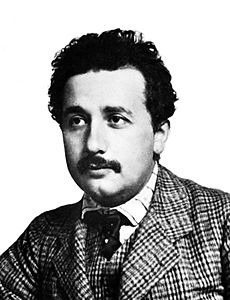
In 1905, while working in a patent office, Albert Einstein published four amazing papers. This year is called his "Wonderful Year."
- He suggested that light acts like tiny "packets" of energy, called quanta, to explain the photoelectric effect. This was a revolutionary idea.
- He explained Brownian motion (the random movement of tiny particles) as proof of atoms and molecules.
- He introduced the theory of special relativity. This theory showed that the speed of light is always the same, no matter how fast the observer is moving. This meant that ideas about time and space had to change. Moving objects would experience time slowing down and length contracting. This paper also said that the idea of a "luminiferous aether" was not needed.
- He deduced the famous equation:
 . This showed that a tiny amount of mass could be turned into a huge amount of energy.
. This showed that a tiny amount of mass could be turned into a huge amount of energy.
These papers were huge achievements, but many physicists didn't notice them at first, or even rejected them.
Mid-1900s: Quantum Electrodynamics
Paul Dirac developed the first quantum theory for how radiation and matter interact in the 1920s. He described the electromagnetic field using ideas of creating and destroying particles. Scientists thought they could calculate anything involving photons (light particles) and charged particles.
However, later studies showed that these calculations only worked at a basic level. At higher levels, they ran into "infinities," which made the calculations meaningless. This suggested a problem between special relativity and quantum mechanics.
In 1938, German chemists Otto Hahn and Fritz Strassmann discovered nuclear fission. They found that bombarding uranium with neutrons split the uranium atom. Lise Meitner and her nephew Otto Robert Frisch correctly explained this as nuclear fission. Hahn later won the Nobel Prize for this.
The problems with quantum theory continued into the 1940s. New measurements showed differences that the theory couldn't explain.
After World War II, Bell Labs created a group to find a solid-state replacement for fragile vacuum tubes. This led to the invention of the transistor.
A solution to the "infinity" problem in electron experiments came from Hans Bethe. He realized that the infinities could be "absorbed" into the known values of mass and charge. This process is called renormalization.
Based on Bethe's idea, Shin'ichirō Tomonaga, Julian Schwinger, and Richard Feynman developed a complete theory called quantum electrodynamics (QED). They won the Nobel Prize in Physics in 1965 for this work. Feynman's method used Feynman diagrams to visualize particle interactions. QED became the model for all later quantum field theories.
Robert Noyce and Jack Kilby independently invented the integrated circuit in 1958. Kilby demonstrated the first working integrated circuit. Noyce's chip, made of silicon, solved many practical problems. Kilby won the 2000 Nobel Prize for his invention.
Philo Farnsworth developed the Farnsworth–Hirsch Fusor in the 1960s. This device was designed to create nuclear fusion. It was the first device that clearly showed it was producing fusion reactions. While it hasn't become a power source yet, it is used commercially as a neutron source.
Parity Violation
Before 1956, scientists believed that the laws of physics were the same in a mirror image. This is called parity symmetry. But in 1956, T. D. Lee and C. N. Yang predicted that this symmetry might not hold true for the weak interaction. In 1957, C. S. Wu and her team proved this. They showed that electrons from cobalt-60 decay preferred to go in a certain direction relative to a magnetic field. This meant that the experiment didn't look the same in a mirror, breaking parity symmetry.
Electroweak Theory
A big step towards the Standard Model of particle physics was Sheldon Glashow's idea in 1960 to combine the electromagnetic and weak interactions. In 1967, Steven Weinberg and Abdus Salam added the Higgs mechanism to Glashow's theory. The Higgs mechanism explains how particles get their mass.
When neutral weak currents were discovered at CERN in 1973, the electroweak theory was widely accepted. Glashow, Salam, and Weinberg shared the 1979 Nobel Prize in Physics. The W and Z bosons, which carry the weak force, were found in 1981, and their masses matched predictions.
The theory of the strong interaction (which holds atomic nuclei together) also took its modern form around 1973-74. Experiments confirmed that hadrons (like protons and neutrons) are made of smaller particles called quarks.
These theories, along with quantum chromodynamics, formed the "Standard Model" of particle physics. This model successfully describes all forces except gravity. Later discoveries like the bottom quark (1977), top quark (1995), tau neutrino (2000), and Higgs boson (2012) have all supported the Standard Model.
The 2000s: New Technologies and Unanswered Questions
Electromagnetic Technologies
New energy technologies are always being developed. By 2007, tiny electric double-layer capacitors were being made for very small electronics. Also, the nanowire battery, a new type of lithium-ion battery, was invented in 2007.
Magnetic Resonance Imaging
Magnetic resonance imaging (MRI) is very important in medicine. Paul Lauterbur and Sir Peter Mansfield won the 2003 Nobel Prize in Physiology or Medicine for their discoveries in MRI. Lauterbur found a way to use magnetic fields to create 2D images quickly.
Wireless Electricity
Wireless energy transfer is the ability to send electrical energy to objects without wires. The term WiTricity was created in 2005. In 2007, a team at MIT successfully powered a 60-watt light bulb wirelessly from 2 meters away. This technology could reduce our need for batteries and might even be used to send information.
Unified Theories
Scientists are still trying to find a Grand Unified Theory (GUT). This would be a model where the electromagnetic, weak, and strong nuclear forces are combined at very high energies. Many ideas have been suggested, but none have been proven by experiments yet.
GUTs are often seen as steps towards a "Theory of Everything" (TOE). A TOE would explain and link all known physical phenomena, including gravity. No such theory has been accepted by scientists yet.
Open Problems
There are still big questions in physics. One is whether magnetic monopoles exist. These would be magnets with only one pole (north or south), unlike regular magnets that always have two. So far, no one has found a magnetic monopole.
Another open problem is understanding high-temperature superconductivity. This is when certain materials lose all electrical resistance at relatively high (but still very cold) temperatures. Scientists are trying to find out why this happens. The ultimate goal is to find a room-temperature superconductor, which would be a huge breakthrough for technology.
Images for kids
-
Electric catfish are found in tropical Africa and the Nile River.
See also
 In Spanish: Historia de la electricidad para niños
In Spanish: Historia de la electricidad para niños


